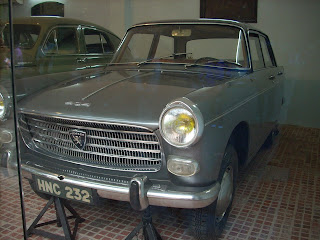Most of the prison has been torn down since the Vietnam War. We are touring the section that remains as an historical site.
 |
| What now remains of Hoa Lo Prison |
Below is a plaque that introduces us to the story as it is told here in Hanoi. Reading the plaque itself is better than my telling it. It suffices to say that this hell-hole has many ghosts, and most were not American. Throughout this tour, there was much writing and video of the war told through Vietnamese eyes. L reminded us early on in the written itinerary that we are not asked to accept it all, but to remember we are guests, and act accordingly. It never hurts to try on the shoes of others, and walk for a bit, even if you go back to your own shoes later.

 There were many photos like this one. Actual shots, and art work created from them. There were tools of torture laid out, and once section just for what happened to women; not all of those torture tools were described, which was fine with me.
There were many photos like this one. Actual shots, and art work created from them. There were tools of torture laid out, and once section just for what happened to women; not all of those torture tools were described, which was fine with me. All of these tools were French made, including the guillotine below. It's not a copy, and there were at least two of them that I saw.
Off hallways like the one below, were cells, virtually windowless, very small. We were there on a cool, cloudy January day. I could only imagine this with 100 degree heat, humidity, and stench.

This Sewer Door is famous now, because it is the famed escape route of over 100 political prisoners in March, 1945, who then participated in the anti-Japanese insurgency August of 1945.
These two photo placards demonstrated U.S. anti-war protests in the mid to late 1960's (above), and protests in Europe as well. (Below)
Below, the Vietnamese version of how our pilots were treated. John McCain has been here, as a visiting former prisoner. Not an easy thing to do, I can only imagine.
And for teachers, or historians, or people who just want to walk a little further, here are a couple of videos that I took with my camera, trying to capture the video looping in Hoa Lo. These tell the story of the war from the Vietnamese point of view, and the second one is the story of capture of American pilots.
I apologize for the amateurish quality, I rushed it, as the bus was leaving.
And as we walk out, our last vision - this wall of pain. It extended around the long side of the museum. Looking up above the wall, we can see the high-rise hotel for people who come to tour. A great deal to digest, here - but we are all very thankful that this place is not now what it once was.
And now, it's time to go home! Well, one of the places we call home, the reason we are here - Laos! After the somber morning, we head for the airport, and jump onto our Lao Airlines flight. Just that thought alone, Laos having its own airline! Vientiane, here we come! For me, it's been over 40 years . . .








.jpg)















